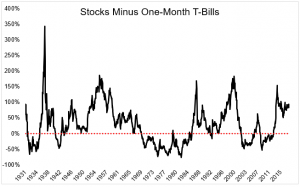What is Market Timing?
Market timing is the act of moving in and out of the market or switching between asset classes based on using predictive methods such as technical indicators or economic data. (Investopedia)
This excerpt sums up Batnick's thoughts:
But 2013-today is just one moment in time, so let’s look at how often cash has outperformed stocks over rolling 5 year periods (after inflation). I was surprised to find that cash outperformed stocks 36% of the time. So maybe you should time the market, just make sure you’re right.
Waiting for a better pitch is always tempting, but timing the market is notoriously difficult, even for the shrewdest investors.
If you have multiple decades ahead of you, there will be plenty of inflection points. Are you going to nail every one of them? And if you’re asking Ben and I whether you should time the market, you probably shouldn’t time the market.
In my opinion, the simple answer to, “Should I Time the Market” is, “Well, it depends.” Here are a few points to consider.
1. Time Horizon Matters
The odds say that a 30 year old probably does not need to time the market. Why? Looking at history, the market goes up more often than it goes down (based on annual returns) so even if you start investing at a poor time, right before the financial crisis for example, sticking to a plan of regularly investing your money should serve you well over time. The important variable here is time. If a 30 year old has 60 years ahead to invest until age 90, that is a lot of time to be a patient investor who allows the market to come back from major bear markets.
What if you're 70 and retired on a fixed income? Then the answer is not so clear. Retiring in 2007 vs 2008 would certainly have had significant differences that could impact one's financial health and lifestyle in a big way.
A few years ago, I was at a presentation where the average age of the audience was about 85. As the speaker talked about efficient market theory, he asked how many in the audience were long-term investors. All hands quickly went up. While some investors who are approaching age 90 have adequate assets to invest for the long-term, in essence investing for the future benefit of their heirs, others do not have the ability to withstand a major market correction. While these investors need their nest eggs to grow, they also need to protect what they have to ensure a better tomorrow.
2. Managing Risk
Are you trying to beat the market? This is where I think market timing gets a bad rap. Critics point to passive investing doing better than active mutual funds that attempt to time the market. Hindsight is 20/20. A nine year bull market is not kind to risk management so passive investing looks more far more attractive today. Make this comparison in March 2009, and managing risk looks to be the wiser choice.
They point that critics miss is that investors want to manage risk where asset protection comes first, with performance considered second. It's like buying insurance to protect against big losses. Not everyone is looking to beat the market. You need to define your goals and investing priorities. The $203.5 billion annuity market is evidence of the many investors who are willing to give up some upside in order to protect against downside. It's best to review your unique needs and objectives relative to your nest egg. Determine the average rate of return you'll need and amount of risk that you can afford to take in order to maintain your financial and retirement plan.
3. Diversification Is Not Always Enough
According to Investopedia, diversification is a risk management technique that mixes a wide variety of investments within a portfolio. The rationale behind this technique contends that a portfolio constructed of different kinds of investments will, on average, yield higher returns and pose a lower risk than any individual investment found within the portfolio.
For many, diversification is the cornerstone for reducing portfolio volatility. Conventional wisdom has argued for years that investors need to spread their investments across a variety of asset classes in order to reduce risk. Thinking back to the last bear market, how well did diversification protect you?
While diversification is important, investors learned in 2008 that during times of crisis, asset classes become more closely correlated. Stated simply, when things get scary in the financial markets, investors and traders sell indiscriminately. In turn, this reduces efficacy of diversification as a tool to soften market volatility.
The IMF published a Global Financial Stability Report in 2015 entitled, “When Market Liquidity Vanishes.” In it the IMF wrote, “Correlations among risk-adjusted returns of major asset classes have increased markedly since 2010. The correlation of the S&P 500 with U.S. high-yield indices has shown a steep increase, and the correlation with commodities has increased fourfold. The substantial rise in correlations between asset markets in advanced and emerging market economies points to an increased possibility of contagion or spillovers in periods of stress.” It continues, “Asset price comovement has become stronger during periods of high market volatility. Correlations normally increase during periods of market turbulence. However,over the past five years, correlations have been rising to much higher levels, often to 0.7 or beyond, in periods of high volatility.”
4. Financial Weather Conditions
If you are willing to attempt to protect your assets from a bear market, my advice is to watch only for major disturbances. History has shown that calling a top is not an easy task so look out for major market cycles, not short-term moves. Using the weather analogy, your odds will be better when monitoring the weather for major storms which means following economic trends and cycles. Recessions do not occur that frequently so watching for signs of economic slow down or weakening corporate profits can indicate when to take cover.
Frequency and severity matter. If you're in a period of a long bull market, trying to manage risk doesn't pay. However, those who lived through Hurricane Katrina or Hurricane Maria understand the importance of having an evacuation plan and that benefit of erring on the side of caution in the face of major storms.
5. Peace of Mind
When it comes to financial storms, damage is not limited to financial hurt. While the last bear market of 2008 took place nearly 10 years ago, many remember the severity well and do not want to repeat the experience. Data shows that bear markets can negatively impact your health. Reducing one's portfolio risk when risk is high can reduce worry and and provide peace of mind.
Closing Thought
Many factors go into an investor's portfolio construction and overall strategy. In my experience, there is a strong desire among retirees and non-profit organizations to protect, not just grow, their assets. Bucking convention does not mean completely disregarding all discipline. Just as there are many different stocks, funds, and exchange traded funds, there are different strategies for controlling and reducing the risk of one's investments. Among them, increasing or reducing your percentage in stocks can be an effective way to tilt your portfolio more aggressively or defensively depending to your view of risk in the financial markets. You may not get it right all the time; but if you can side step even part of a major bear market, you'll have reduced your risk and likely slept a lot better because of it.
How concerned are you about the next market correction? Are you doing anything differently to protect your portfolio?
“Rollercoaster” by m.prinke is licensed under CC BY-SA 2.0







